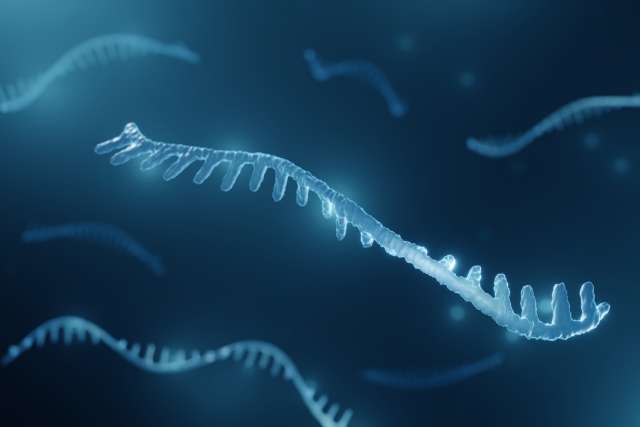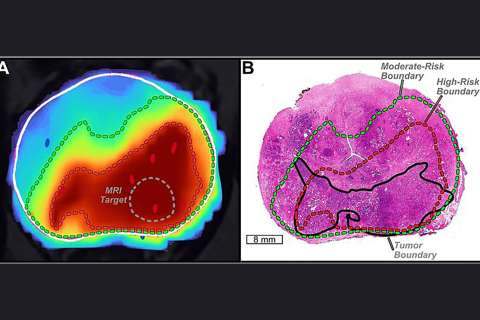Investigators at the UCLA Health Jonsson Comprehensive Cancer Center have validated a test that can accurately predict which patients with prostate cancer are at higher risk of developing long-lasting urinary side effects after receiving radiation therapy.
The test, called PROSTOX, is the first of its kind to use microRNAs to predict toxicity from cancer therapy. It could help prevent the burden of long-term complications by identifying patients most at risk before treatment even begins.
In a study published in Clinical Cancer Research, a journal of the American Association for Cancer Research, the UCLA team validated PROSTOX’s ability to predict long-term urinary side effects, which can include urinary tract pain, blood in the urine, increased frequency of urination, and urinary urgency or leakage. The researchers also found that different genetic factors are linked to different types of side effects, reinforcing the need for more personalized approaches to treatment.
“We’ve always known that some men develop these life-altering side effects that they will carry through the remainder of their lives, but until now, we didn’t have a way to predict who,” said Joanne Weidhaas, MD, PhD, professor of radiation oncology and vice chair of molecular and cellular oncology at the David Geffen School of Medicine at UCLA, and senior author of the study. “What makes PROSTOX different is that it looks at a patient’s unique genetics to estimate their personal risk of developing side effects from radiation. This helps doctors and patients choose the safest treatment and avoid unnecessary toxicities.”
Many men with early-stage disease are treated with stereotactic body radiotherapy (SBRT), a highly precise form of radiation therapy delivered over just five sessions. It’s faster and more convenient than traditional radiation, which typically requires weeks of daily treatments.
But like all forms of radiation therapy, SBRT still can cause side effects. While severe side effects are uncommon, a minority of patients do develop moderate toxicity that could require medication and impact quality of life. There are currently no known interventions shown to prevent, slow, or reverse late radiation-associated toxicity.
A common problem patients may have after radiation is urinary side effects that can disrupt daily life, like frequent trips to the bathroom, pain, and an urgent need to go that doesn’t always come in time.
These side effects can happen right away (acute toxicity), much later (late toxicity), or start early and never go away (chronic toxicity). Even with the most advanced radiation techniques, some patients still develop these side effects, and it’s hard to know how they will respond to the stress of radiation.
In earlier work, Weidhaas and her team discovered that certain inherited genetic differences, especially in areas related to microRNAs, which help control how genes work, can predict how likely someone is to have these side effects. In partnership with MiraDx, the team used this information to develop the genetic test PROSTOX, which identifies 32 unique mirSNPs that are linked to radiation-related side effects and separates patients into low-risk and high-risk groups for developing serious long-term urinary side effects after SBRT. They found people in the high-risk group are about 10 to 12 times more likely to have problems.
In the new study, the researchers set out to confirm that PROSTOX works in a new group of 148 patients with prostate cancer receiving either MRI- or CT-guided SBRT from a phase III clinical trial at UCLA called MIRAGE. In addition, the team used machine learning, a type of artificial intelligence, to develop new models to predict acute and chronic urinary toxicity.
They confirmed that the test can successfully predict which patients will develop significant late urinary toxicity, regardless of whether the radiation was guided by MRI or CT. They also found that PROSTOX wasn’t influenced by other clinical factors, such as age or radiation dose, indicating that it detects an independent, genetic risk for toxicity.
The study also distinguished between two separate types of radiation-induced urinary side effects: chronic toxicity and late toxicity. Using genetic analysis, the team found these forms of toxicity have unique genetic signatures, suggesting they arise from different biological mechanisms.
Late toxicity seems connected to immune system dysfunction and long-term inflammation and chronic toxicity might be more affected by advanced technology, meaning better radiation techniques could help reduce these issues.
“Advancements in radiation technology, treatment planning, patient care, and follow-up make it challenging to directly compare toxicity between older and more modern treatment approaches,” said Amar Kishan, MD, executive vice chair of radiation oncology at the David Geffen School of Medicine at UCLA, and first author of the study. “Despite these challenges, this study validated PROSTOX as a predictive biomarker and confirmed that a genetic predisposition to increased toxicity persists with modern, high-precision SBRT, including MRI-guided SBRT. This finding reinforces PROSTOX as a true measure of the biological response to radiation, independent of treatment era or technique that can identify the safest course of treatment to avoid toxicity.”
Building on these findings, the team emphasizes the importance of integrating genetic testing with modern radiation therapy to further personalize prostate cancer treatment.
“This genre of genetic testing combined with advanced radiation therapy techniques will help personalize treatment for prostate cancer patients, mitigate the risk of serious GU side effects, as well as give doctors and patients important information to make the best and safest treatment choices,” said co-author Michael Steinberg, MD, professor and chair of radiation oncology at the David Geffen School of Medicine at UCLA and director of Clinical Affairs at the UCLA Health Jonsson Comprehensive Cancer Center.
The researchers are working to expand PROSTOX validation in larger patient populations. They are also exploring similar genetic biomarkers to predict side effects in other cancers treated with radiation and immunotherapy.
“With further research, we hope to apply these genetic insights across cancer care,” said Weidhaas. “Ultimately, we want patients to survive cancer and live well after treatment.”
Other authors, all from UCLA, are Kristen McGreevy, Luca Valle, Beth Neilsen, Maria Casado, Minsong Cao and Donatello Telesca.
The study was supported in part by grants from the National Cancer Institute.
Weidhaas co-founded MiraDx, the company that developed PROSTOX and licensed intellectual property from Yale University related to microRNA-binding site variants.






